THE INFINITE is not only one of the most visually stimulating XR exhibitions in recent memory but also, and perhaps surprisingly, a remarkably moving experience.
This review was initially published in French on Québec/Canada XR, July 21, 2021, for the Montreal exhibit, which was the first stop of THE INFINITE tour.
Midway through the hour-long journey of THE INFINITE, during a ten minutes 360° video sequence shot from within the International Space Station’s observation cupola, I was able to put myself in the shoes of an astronaut and observe the earth from a point of view that fewer than 400 individuals have had the privilege of occupying in the history of humanity. While I was comfortably seated in an old factory converted into an art gallery in Montreal—during the exhibit’s first showing last summer in Canada—, the vistas I was shown transported me some 400 km (200 miles) away, orbiting the earth. This is how I was able to experience the so-called “overview effect,” a kind cognitive shock that affects those who get to see the earth from space or the moon and who, as a result, are confronted to a completely different perspective; a point of view beyond the limits of human understanding. As someone who has been studying this phenomenon for several years (i.e., the idea of seeing things from a perspective so radically different than one’s own), the chance to see these images with my own eyes moved me to such an extent that I could not refrain from shedding a few tears. Months later, I still get goosebumps when I recall this feeling.
Presented at Sawyer Yards in Houston from December 21, 2021, to February 20, 2022, THE INFINITE is a new 1000 m2 (10,000 ft2) immersive exhibition created by Felix & Paul Studios and produced by PHI Studios, in partnership with Time Studios. Over the hour-long course of the exploration, visitors are invited on a luminous exploration of new worlds—and of new ways of seeing the world. While you might have seen some of the images the Canadian VR studio shot aboard the International Space Station (ISS) as part of the Space Explorers series, I would go as far as saying you have not truly seen them until you journey through THE INFINITE.
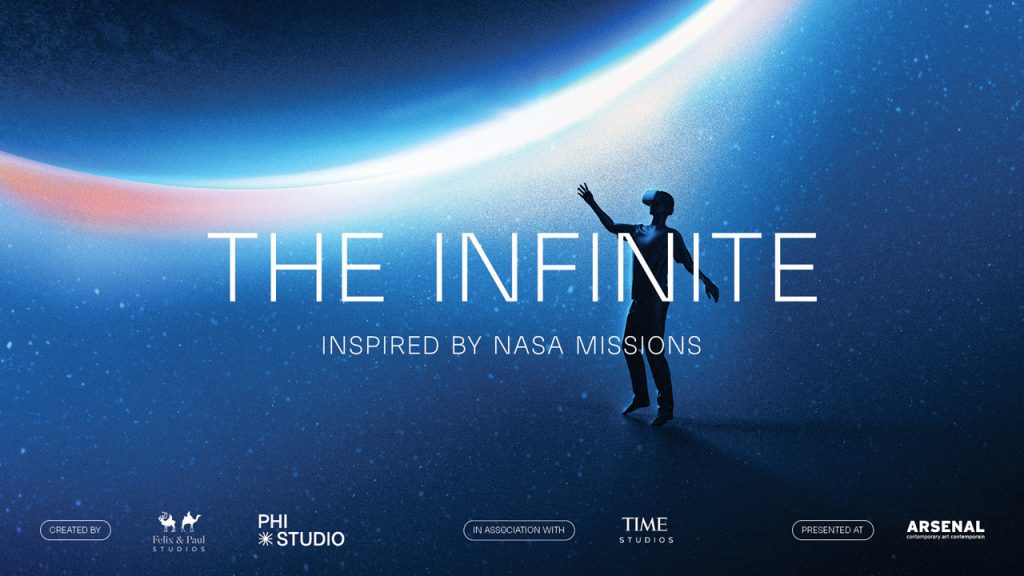
THE INFINITE, a Space Exploration
While it is inspired by NASA’s missions and although the images that Felix & Paul brought back from the ISS are still at the heart of the exhibition, THE INFINITE is not just about space. As the narration heard during the first phase of the exhibition suggests, the journey is also marked by a yearning for discovery; of space, yes, but also of the world, of what drives us and, ultimately, of what unites us.
For Félix Lajeunesse (Co-founder and creative director of Felix & Paul), “space exploration is an infinitely vast subject.” That’s why THE INFINITE invites visitors to approach the topic from a more emotional, visceral, or even more spiritual point of view. Space—and the spirit of discovery that led us to it—is a topic that touches most of us in some shape or form. As such, everyone is likely to take something unique out of the experience. Lajeunesse also hopes that this exhibition—and notably VR—might allow people to relate more viscerally to the topic than if they had discovered it in a planetarium or science centre. In the end, the hope is that the public can be moved—even profoundly transformed—by the immersive journey that THE INFINITE has to offer.
And considering 70% of the over 70,000 visitors of the exhibition’s first stop in Montreal were first-time VR users, one also wonders what a profound impact THE INFINITE might have on the public perception of virtual reality.
“We aim to create a suspending disbelief for the viewer” – Paul Raphaël (Felix & Paul)
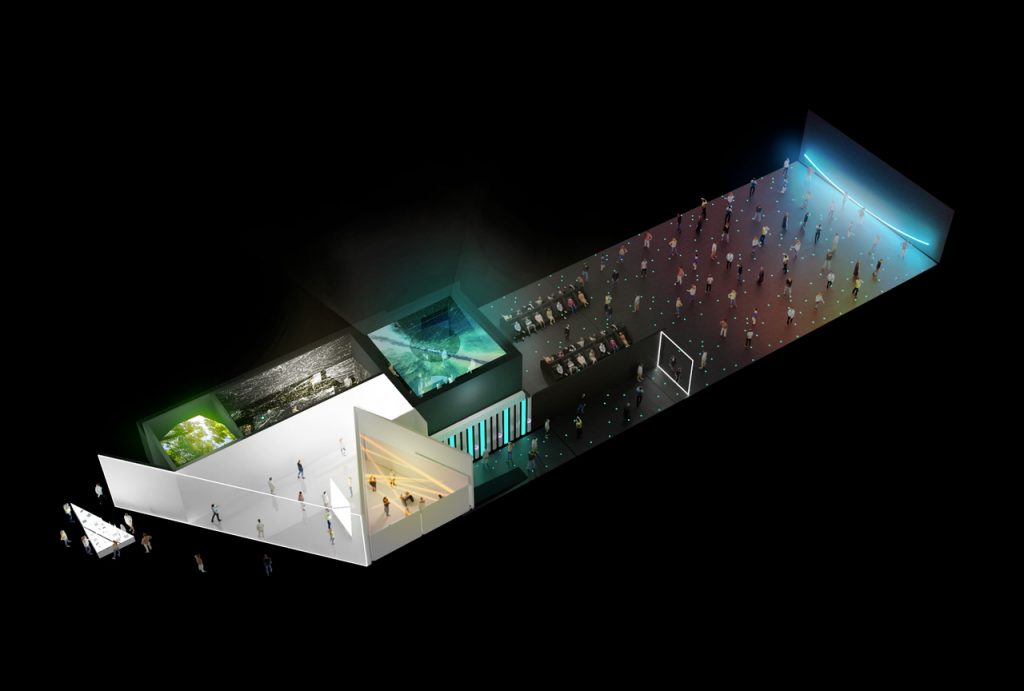
A trek through space by Felix & Paul Studios
THE INFINITE covers an expanse of more than 1000 m2 (10,000 ft2) divided into seven zones that lead visitors on a trip from to earth to space, and back. After passing through an airlock that introduces them to the themes of the exhibition, visitors are invited onto the “boarding” dock where docents are waiting to help them adorn specially modified Meta Quest 2 headsets, fresh out of a round of UV disinfection.
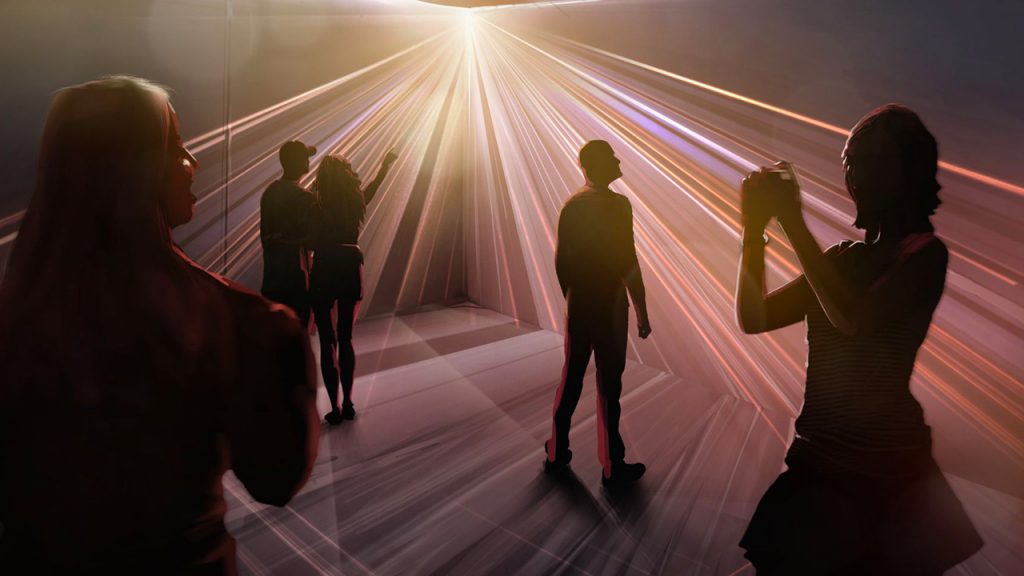
Headsets on, visitors are invited to cross a portal and take their first steps into outer space. Here begins the core component of the exhibition. For more than half an hour, visitors are encouraged to roam freely in (and out of) a 1:1 reproduction of the ISS, dotted with colourful orbs. These contain the 360° video content filmed by Felix & Paul on board the orbital laboratory with custom-built Z-Cam Pro cameras. This 3DoF video content is divided into four chapters that organize the testimonies of astronauts from different space agencies into common themes (e.g., adaptation, progress, unity, expansion). These chapters are also bridged by interludes, including a sequence dubbed the “cosmic ballet” where the planets and constellations can be seen crossing paths through the night sky.
It should be noted that the quantity and duration of these videos far exceed the thirty-five minutes allotted to the free-roaming section of the exhibition. After four or five visits, I was still discovering content I had never seen before. If my sources are correct, visitors of THE INFINITE in Houston will also get the chance to see some never-before-seen images: a spacewalk shot in VR in September 2021.
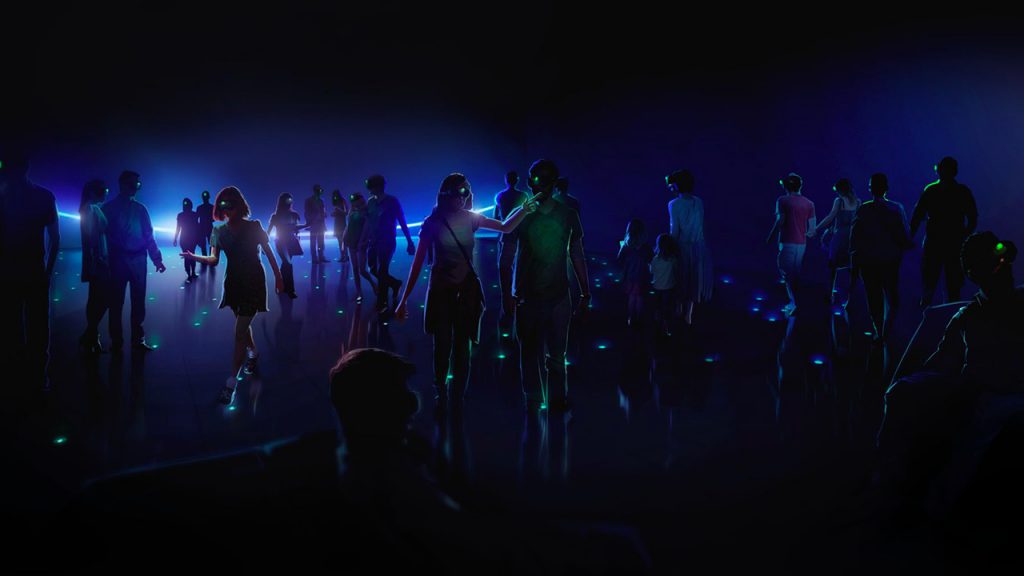
Free roaming in 10,000 ft2
Since it is impossible to see everything in one visit, there is room to experiment with the order in which one chooses to view these videos. Similarly, I encourage intrepid visitors to venture off the beaten path and cross from one capsule to the next through the void of interstellar space. You won’t have to worry about the lack of oxygen or exposure to solar radiation, but be careful not to run into the dozens of other people who are also blindly circulating in this space. Fortunately, the producers of THE INFINITE developed an ingenious tracking system that identifies other patrons; at first barely perceptible as floating points of light, these materialize into starry avatars when it comes time to avoid collisions.

This system allows more than a hundred people an hour to cross paths without ever bumping into each other. Couples, families, and friends will also be able to recognize each other thanks to their orange hue that distinguishes them from other people, represented by blue avatars. At the same time, those who feel less comfortable with virtual reality—or with the idea of free roaming blindly within a crowd—can count on the guiding hand of a friend or loved one. Interestingly, Coline Delbaere (Producer, interactive experience, PHI Studios) and Julie Tremblay (Producer, Installations and Touring Exhibitions, PHI Studios) have each mentioned to me how surprised they were to see couples holding hands over the course of the experience. Some were even seen trying to sit in the same chair in the next portion of the exhibition.
Breathtaking views of the ISS… and Space!
Once the space exploration phase is over, a starry pathway guides visitors to the fourth component of the exhibition, the above-mentioned panoramic sequence. With sweeping orchestral music worthy of the best science fiction films, this video sequence offers a series of contemplative look at the Earth’s surface as seen from orbit. Some viewers might recognize particular coastlines or landmarks, while others will simply enjoy seeing these otherwise familiar landscapes from this incredible perspective. One thing is certain: the overview effect is there for those willing to give themselves over to it and to its striking ability to shed new light onto the world as we think we know it. There is something truly awe-inspiring about this opportunity.

The shock of the return: the last rooms
While the virtual reality portion of the exhibition might end with the “spacewalk” sequence, the journey continues with a trio of immersive multimedia installations guiding visitors back down to earth. The first and most visually striking of the three is a piece of video art by Ryoji Ikeda titled The Universe Within the Universe. The installation takes the form of a room with a circular mirror on the floor—standing in for a black hole—and a ceiling entirely composed of LED screens that illuminate the volume with ever-changing images of a vaguely scientific nature (composites of topological maps, spectrographic imaging, data points, etc.). The fact that one has to look down through a mirror at the ceiling and that one’s entire field of vision is filled with colour and movement can have a vertiginous, even intoxicating effect; as if travelling without moving.
The dazzling effect of the visual artist’s well-known aesthetic—marked by flashing lights and the use of raw data—has the potential to shock visitors, especially after the Zen feeling cultivated throughout the first four stages of the exhibition. Despite the potential visual shock, Universe remains an amazing installation that complements the concern for space exploration and the fascination for light that truly defines THE INFINITE.

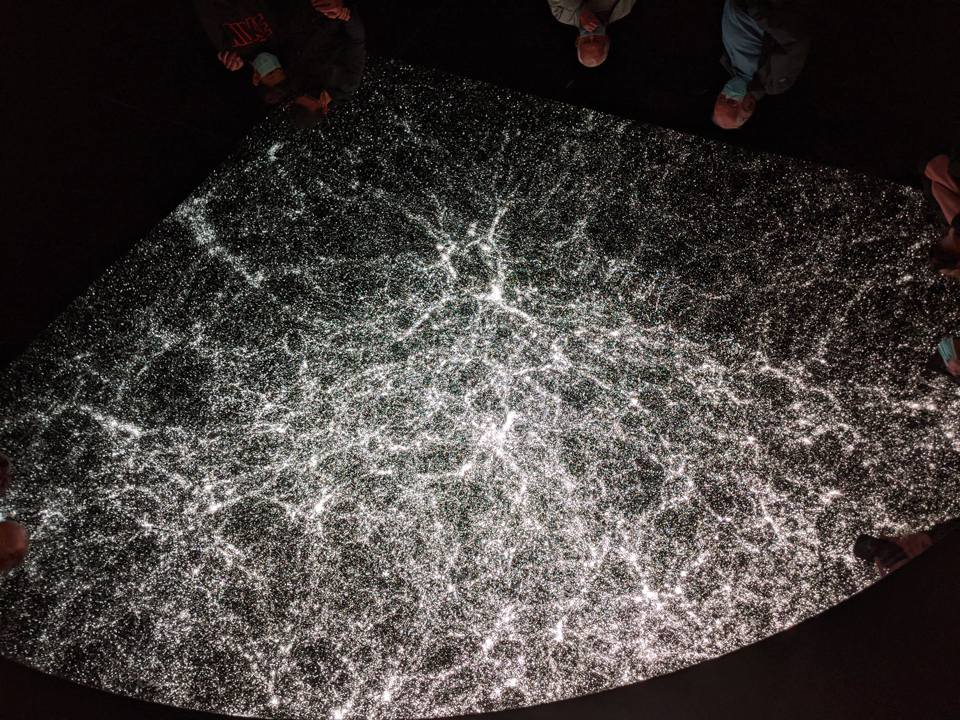
The journey continues with DARKMATTER: Hypothetical Form, Supersymmetry by George Fok, an installation that takes the form of a corridor lined with mirrors and screens featuring images that evoke a wormhole, transporting visitors back to earth. This return is marked by the final space of the exhibition, a dark room pierced by a ray of light descending from the tree-lined sky, hinting at a potential return of nature.
In the vein of installations such as George Fok’s own Seeking Stillness, which was shown by PHI Centre as part of their “Emergences & Convergence” exhibition in the summer of 2020, these last two spaces play with light and space to immerse visitors in different space-time configurations. It wouldn’t be surprising to see social media flooded by photos taken in these two spaces in months to come.
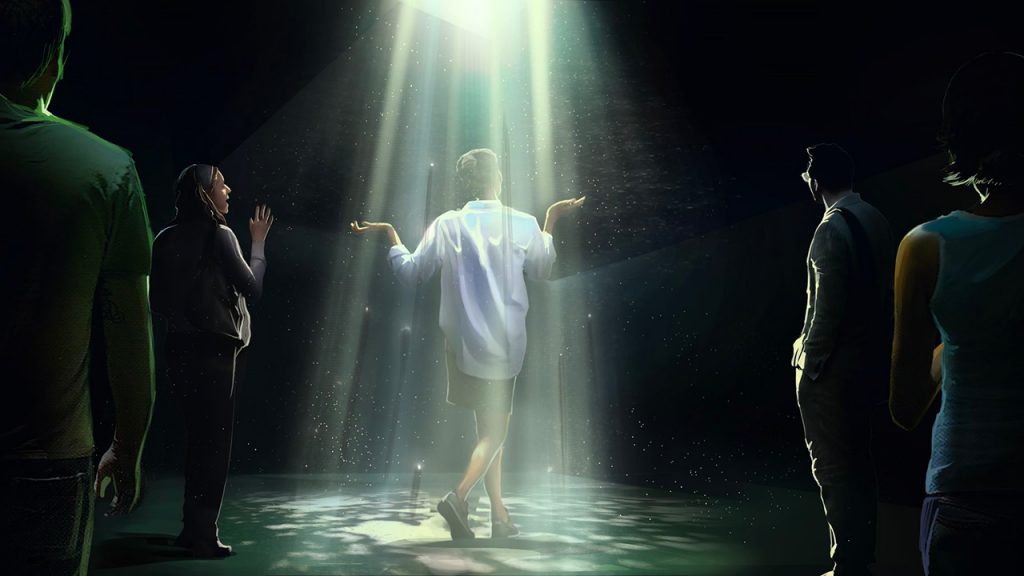
Back to Earth
THE INFINITE is a tour de force in terms of immersive exhibitions, marking a shift in both what audiences know VR to be, and what we might expect VR to be capable of in the futre. In addition to the 360° video content filmed in space, which is a feat in and of itself, the balance struck between the different components of the experience is what sets this exhibition apart from other examples in recent memory, whether from the field of virtual reality or the world of immersive and interactive installations. From the onboarding phase that sets the tone for the rest of the journey to the three luminous installations that guide visitors back to earth at the end of the trek, everything is designed to accompany the public through an almost mystical exploration of space. Annabelle Fiset (Creative Director, THE INFINITE) explains that considerable work went into designing spaces that would weave together the different components of the show, which include both 3DoF and 6DoF content, several audiovisual installations, as well and as countless logistical elements that simply could not be ignored.
One example of this is the headset processing station, which makes it possible for all devices handed in by patrons at the end of their experience to be disinfected and prepped for the next round of visitors. This process happens so seamlessly and is so well integrated into the design of the experience that it would be easy to lose sight of it. Add to this the presence of docents throughout the experience who make sure the exhibition runs smoothly, most of all during the VR free roaming stage. Although some tracking issues can still occur, there is always someone at the ready to solve these problems. All aspects of the exhibition are designed to ensure that the experience is smooth from start to finish, a success in and of itself considering the still experimental state of today’s virtual reality technologies.
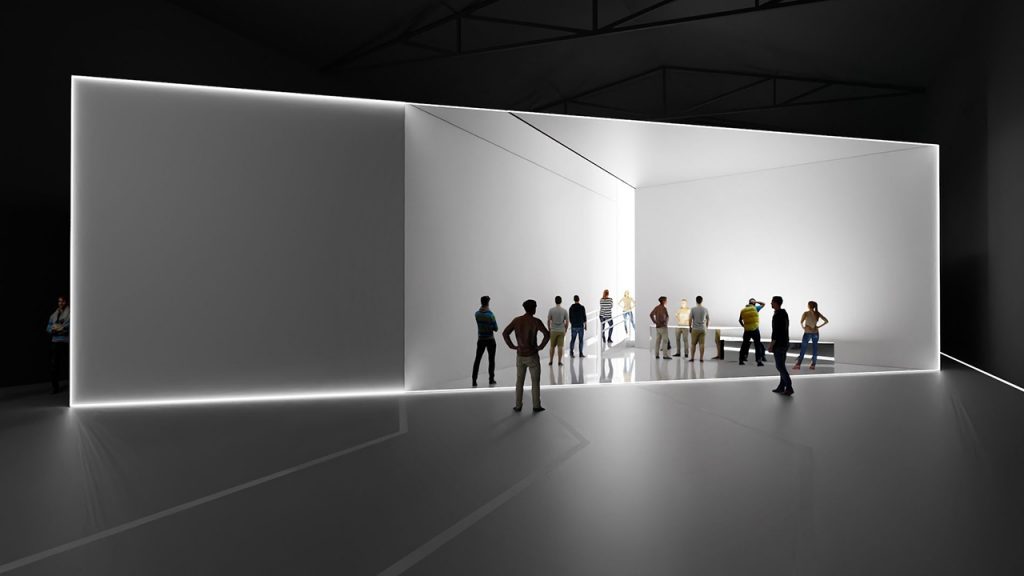
Furthermore, I’ve yet to mention the accessibility options put in place to ensure even those who cannot wear a VR headset—whether it be due to age, disability, discomfort, etc.—can explore THE INFINITE both safely and comfortably. In addition to VR headsets, then, visitors of THE INFINITE can also view content on a tablet. Speaking of accessibility concerns, Julie Tremblay explains, “we have people coming in wheelchairs every day. If I don’t make this issue a priority, then every day we have people going through an experience that wasn’t fully thought out for them.”
For Pierre Blaizeau (Chief Technology Officer, Interactive Experience), one of the aims of the exhibition is to make virtual reality more accessible, especially to a wider audience for whom THE INFINITE may be the first encounter with this still relatively new technology. With a popular theme like space exploration, one can easily imagine that a majority of the public, perhaps initially attracted by the topic, may also discover this new medium for the very first time. Data from the first stop of the exhibition’s tour in Montreal are encouraging in that respect.
A giant leap for the XR community
In many ways, the teams over at Felix & Paul and PHI Studios are pioneers. However, as Mads Damsbo (Makropol) recounted in a recent interview, “a pioneer is no good if he never comes back to tell you what it looks like over there. […] it doesn’t make sense to go first if you don’t bring everyone with you.” With this, I hope Felix & Paul, PHI and all their teams can continue to pave the way and share their discoveries with us, so that THE INFINITE might one day represent a giant leap for the entire XR community.
In the meantime, I hope that more and more people will be able to experience virtual reality through this dazzling exhibition. Don’t miss your chance to experience this incomparable immersive exhibition, presented from December 21, 2021, to February 20, 2022, at Sawyer Yards in Houston, with more dates and cities to be announced soon.
THE INFINITE (December 21, 2021 – February 20, 2022)
Silver Street Studios | Sawyer Yards
2000 Edwards Street, Houston, TX 77007, Gate A




Leave a Reply
You must be logged in to post a comment.